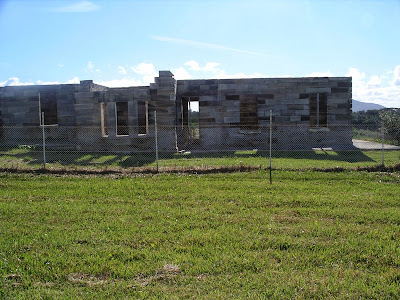With the distinctive 'broad arrow', signifying 'government manufacture', it would be a true relic of the convict days of the early Colony.
 |
Convict brick on display at the Rocks Discovery Museum,
Sydney. Photo taken 21 November 2013.
|
The history of Dawes Point, under the southern pylon of Harbour Bridge, is a story in itself. It has many layers dating back to 1789 when it became the site of Sydney's first fortification, through to the construction of the Bridge in 1925-1932, and to today's parkland.
In searching though newspaper articles at the time of construction of the Sydney Harbour Bridge, through the resources of TROVE (online information service of the National Library of Australia) we can piece together the typical finds of convict relics in the vicinity of Dawes Point:
Convicts Bricks and Stones
"To the opulent collection of relics of old Sydney, yielded by excavations for the harbour bridge, there was added yesterday a battered brick, found at Dawes Point, and was made probably more than 100 years ago. It was in fair condition,[and] bore the broad-arrow imprint.............
Dr Bradfield says the brick probably came from the old water police court at Dawes Point which had to make way for the bridge approaches, and which was built from the materials in the fort and observatory put up at the point from the earliest days of the colony."
[Sydney Morning Herald, Thursday 13 August 1931 page 8].
Was this Ernest's Brick?
"From this building he [Dr Bradfield] had [also] recovered an old sandstone block in which were rudely chiseled the figure 1789, and the initials R.R.- those of Major Robert Ross, the first Lieutenant-Governor, who came out in the first fleet. This stone, which Dr Bradfield gave to the Royal Historical Society, is claimed to be the first quarried for a Sydney building".
[Sydney Morning Herald, Thursday 13 August 1931 page 8]
 |
Stone bearing the imprint of 1789 and the initials 'R R'
on display at the Rocks Discovery Museum, Sydney.
Photo taken 21 November 2013.
|
A photograph of it and other stones obtained during the excavation work for the Harbour Bridge was published in the Sydney Morning Herald, Saturday, 15 August 1931, page 14.
 |
| Sydney Morning Herald, 15 August 1931, page 8. Photo from Daily Telegraph article 17 October 2013 |
"Another link with the past was removed yesterday when employees of the Public Works Department dislodged the stone foundations of the old Dawes Point fortifications. A flight of steps led to three dark, dungeon-like chambers. Ventilation was supplied by means of a six-inch earthenware pipe leading to the surface. It was stated that the basement was one used for confining incorrigible convicts..........."
[Sydney Morning Herald, Thursday 25 February 1932 page 13].
Wooden Pipes
"Workmen engaged in making excavations near Wynyard-square for the supports for the approaches of the Sydney Harbour Bridge, discovered yesterday some old pipes which are believed to have been made by convicts when Port Jackson was a penal settlement. They were located near a disused well some 30 to 38 feet below the present surface of the street. They appeared to be hollowed from limbs and stems of trees, probably ironbarks, and were in a fair state of preservation...............They created considerable interest, and were inspected by Dr J.J.C. Bradfield , chief engineer of the Sydney Harbour Bridge".
[Sydney Morning Herald, Friday 11 March 1927, page 11].
"Another relic.....is a tombstone found when workmen were demolishing a row of houses to make way for the northern approaches to the bridge. It was apparently an ordinary paving stone in a yard over which generations of children had scampered. But when it was turned over it was found to bear the inscription 'Sacred to the memory of Peter Crawford, first officer of the ship Surrey, who died of typhoid fever, 1806'. The Surrey, Dr Bradfield said, was a convict ship".
[Sydney Morning Herald, Thursday 13 August 1931 page 8]
A Pump
" One relic of definite historic value consists of a portion of a pump for a well sunk in 1828 of 1829 by that early pioneer, John Busby, and uncovered at the Wynyard -square excavations. There is a section of a wooden pipe, about nine inches square, and made of ironbark, through the centre of which is bored longitudinally a hole four inched in diameter, and there is is also the lifting bucket, the lifting shaft, and a clack valve of lead and leather...".[Sydney Morning Herald, Thursday 13 August 1931 page 8]
History Services NSW has extensive records of convicts who were assigned to the Dawes Point area.
If you are researching a convict ancestor who was assigned to the Dawes Point, you should go to our website at: http://www.historyservices.com.au/convicts.htm****************************************************************************
Blog prepared by Mary McGuinness
I refer you to Trove's newspaper collection which includes digitised historic and modern newspapers which are accessible on line, as well as newspapers in microform and paper formats. Go to the website:
http://trove.nla.gov.au/
Photos taken on site at The Rocks Discovery Museum, 21 November 2013.
I refer you to Trove's newspaper collection which includes digitised historic and modern newspapers which are accessible on line, as well as newspapers in microform and paper formats. Go to the website:
http://trove.nla.gov.au/
Photos taken on site at The Rocks Discovery Museum, 21 November 2013.
.JPG)
.JPG)
.JPG)
.JPG)
+Copy+1.jpg)



.JPG)























.JPG)
.JPG)















